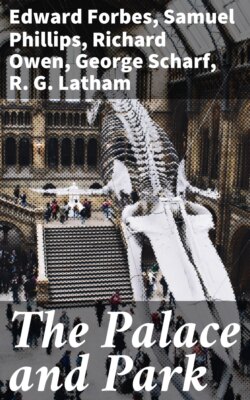Читать книгу The Palace and Park - Edward Winslow Forbes - Страница 13
На сайте Литреса книга снята с продажи.
ОглавлениеGround Plan of English Mediæval Court.
Entering the Court from the Nave, we find, immediately facing us, the magnificent doorway from Rochester Cathedral, coloured so as to give an idea of its appearance when first erected. The different faces, “making mouths,” introduced amongst the tracery of this door, afford a good example of the grotesque spirit which forms so strong an element of Gothic architecture. We may remark here that the practice of colouring and gilding was carried to an almost extravagant extent in the Gothic style, although the effacing hand of Time has left comparatively few examples in a perfect state.
Doorway from Rochester Cathedral.
On the left of the door is a portion of the arcading from the Chapter House of Wells Cathedral, and next is the richly-decorated Easter sepulchre, from Hawton Church, Nottinghamshire, representing the Resurrection and Ascension of Christ—a very remarkable monument of the 14th century. At the foot are the soldiers on guard at the Sepulchre, sleeping, and in the centre (the altar-table) the Resurrection of our Lord, bearing his cross; the three Marys in adoration at his feet. Above is the Ascension, the Apostles standing around. This last subject is treated in an original and ingenious manner, to come within the lines of the architecture. This monument was used as an altar; various rites being performed before it, between Good-Friday and Easter-day. A seated figure, from the front of Lincoln Cathedral, is the next subject; and further on, in the angle, is a Virgin and Child, in a niche—a beautiful piece of early 14th century work from York Minster; and next is a portion of Bishop Alcock’s chantry chapel, from Ely Cathedral; on the other side of the adjoining doorway, which is a composition chiefly from the triforium of Lincoln Cathedral, we remark the very beautiful oriel window of John o’Gaunt, at Lincoln, and next to it a portion of the elaborate altar-screen of Winchester Cathedral.
On the right of the Rochester door is the finely designed monument of Humphrey de Bohun, from Hereford Cathedral, with the effigy of the knight in complete armour. Next to this, in the angle, we see the recumbent figure of the “Boy Bishop” from Salisbury Cathedral. It used to be the custom in the Catholic Church, annually to elect a bishop from the children of the choir, who, throughout the year, kept all the state of a regular bishop; and, in the event of his dying within the period of his office, had his effigy erected as here we see. For further particulars of this singular custom, see the “Handbook of the Mediæval Court.” The door beyond corresponds to the one opposite; and further on, near the cloister, is one of the doors of Lichfield Cathedral, with its beautiful ironwork, the painting of which, to represent oak, is remarkably clever; and a portion of Bishop Bubwith’s monument from Wells. The exquisite niches and canopies round the walls of the court are from Southwell Minster, Ely Cathedral, Beverley Minster, &c. The statues on a line with, and corresponding to those on the monument of Bishop Bubwith, are excellent examples of late Gothic work, from Armagh Cathedral. The upper tier, consisting principally of sculpture, presents valuable examples of that art. The large statues beneath the canopies are from the façade of Wells; they are all of the highest interest with reference to the history of sculpture in England. The floor presents a remarkable and interesting series of the best sepulchral monuments of the Gothic period which England possesses, viz., those of Queen Eleanor, from Westminster; Edward II., from Gloucester; the celebrated monument of William of Wykeham, from Winchester; and that of Edward the Black Prince, in gilt armour and emblazoned surcoat, from Canterbury Cathedral. The individuality observable in most of the faces indicates that they are portraits. The very lovely face of the good Queen Eleanor should not escape the notice of the visitor.
Elevation of English Mediæval Court towards the cloister.
Indeed all the subjects in this Court are full of value and interest, and the numerous examples of Gothic art here collected, which we have not space to describe in detail, form a museum in which the visitor may obtain no inadequate idea of the rich treasures in this wise of our country. Passing beneath the Rochester doorway, we enter a vaulted and groined vestibule, the window of which is a beautiful example of the Decorated style, from Holbeach, in Lincolnshire, filled in with rich stained glass. Beneath the window is the painted monument of John of Eltham, son of Edward II., from Westminster Abbey, on either side statues from Wells Cathedral. In the centre is the very richly-decorated font, from Walsingham, in Norfolk, an excellent example of the Perpendicular style. The walls of the gallery are lined with statues and monuments; those on the Garden side are all English, principally from the façade of Wells Cathedral; those on the side of the Court are chiefly from Germany and France. Amongst the latter, we draw particular attention to the bas-reliefs on the walls, from Notre-Dame, Paris, as excellent examples of early French Gothic. Amongst the central monuments should be particularly remarked, behind the German Mediæval Court, the Arderne tomb, from Elford church, Staffordshire; the monument of Henry IV., and Joan of Navarre (his queen), from Canterbury Cathedral; the tombs of Sir Giles Daubeny, Richard II., and Anne of Bohemia (his queen), from Westminster Abbey, of about the year 1507; and behind the French and Italian Mediæval Court, the splendid monument of Richard Beauchamp, Earl of Warwick, from Warwick, one of the finest Gothic sepulchral monuments remaining in England. Passing beneath the arcade, near the Beauchamp monument, we enter the next architectural illustration of the series.
